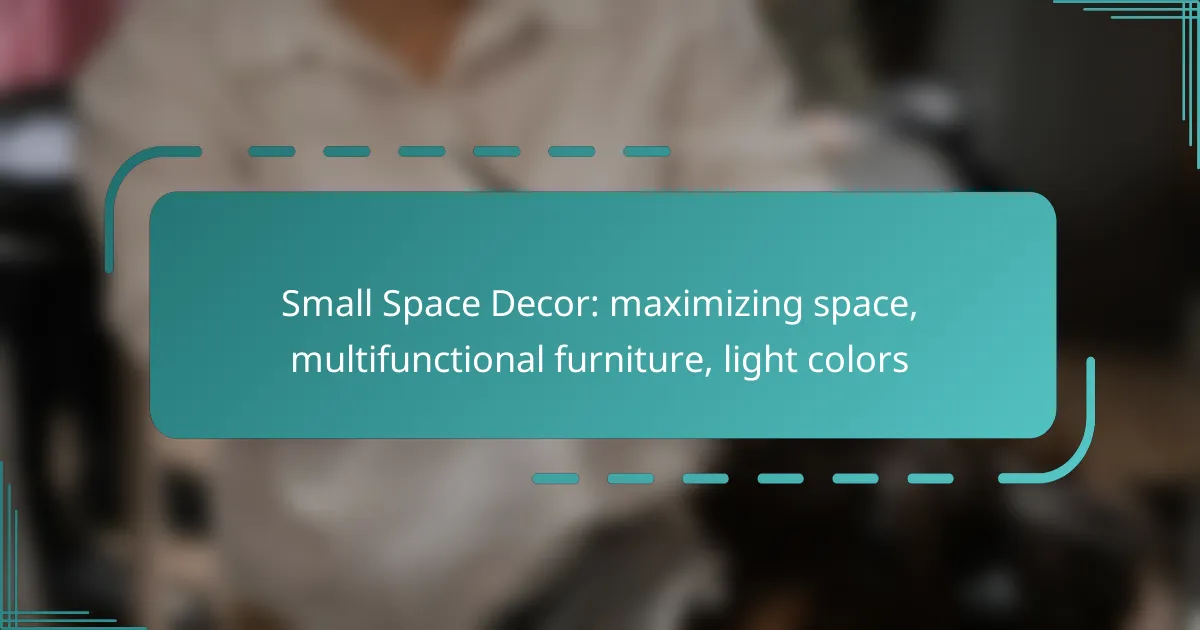Decorating small spaces requires thoughtful strategies to maximize functionality and create an inviting atmosphere. By incorporating multifunctional furniture and utilizing light colors, you can enhance the perception of space while ensuring your home remains stylish and practical. Emphasizing organization and a clutter-free environment will further contribute to a more open and airy living area.

How to maximize space in small homes?
Maximizing space in small homes involves strategic organization and smart furniture choices. By utilizing vertical space, opting for multifunctional furniture, and maintaining a clutter-free environment, you can create a more spacious and functional living area.
Vertical storage solutions
Vertical storage solutions are essential for making the most of limited floor space. Consider installing shelves that reach up to the ceiling, using tall bookcases, or incorporating wall-mounted cabinets. These options draw the eye upward and free up valuable ground space.
Utilizing hooks and pegboards can also help keep items organized while adding decorative elements. For example, hanging pots in the kitchen or displaying art supplies in a craft room can enhance both functionality and aesthetics.
Multi-functional furniture
Multi-functional furniture is a game-changer in small spaces, allowing you to maximize utility without sacrificing style. Look for items like sofa beds, ottomans with storage, or dining tables that can expand when needed. This versatility helps you adapt your space for various activities.
When selecting multifunctional pieces, consider the materials and design to ensure they blend seamlessly with your decor. For instance, a sleek, modern coffee table that doubles as a storage unit can enhance both practicality and visual appeal.
Decluttering techniques
Effective decluttering techniques can significantly enhance the feeling of space in small homes. Start by assessing your belongings and identifying items that you no longer use or need. Implementing the “one in, one out” rule can help maintain a manageable amount of possessions.
Regularly scheduled decluttering sessions, perhaps every few months, can prevent accumulation. Consider donating or selling items that are in good condition, which not only clears space but also benefits others.
Using mirrors to create depth
Using mirrors strategically can create an illusion of depth and openness in small spaces. Placing a large mirror opposite a window can reflect natural light, making the room feel brighter and more expansive. Additionally, mirrored furniture can add a touch of elegance while enhancing the sense of space.
Consider incorporating smaller mirrors in various areas to break up wall space and add visual interest. Arranging a gallery of mirrors can also serve as a stylish focal point while contributing to the overall spacious feel of the room.

What multifunctional furniture is best for small spaces?
Multifunctional furniture is essential for maximizing small spaces, as it serves multiple purposes while saving room. Key pieces include convertible sofas, expandable dining tables, and storage ottomans, which enhance functionality without compromising style.
Convertible sofas
Convertible sofas are versatile seating options that can transform into beds, making them ideal for small living areas. When selecting a convertible sofa, consider the ease of conversion and the comfort level of both the sofa and bed configurations.
Look for models with built-in storage or additional features like reclining capabilities. This type of furniture can serve as both a stylish couch during the day and a comfortable sleeping space at night, maximizing utility in limited square footage.
Expandable dining tables
Expandable dining tables are perfect for small dining areas, as they can adjust in size based on your needs. These tables often feature drop leaves or extendable sections, allowing you to accommodate extra guests without taking up unnecessary space.
When choosing an expandable table, consider the material and design to ensure it complements your decor. A table that expands from a small size to fit four or more people can significantly enhance your dining experience while maintaining a sleek profile when not in use.
Storage ottomans
Storage ottomans serve a dual purpose as both seating and hidden storage, making them a practical choice for small spaces. They can hold blankets, magazines, or other items, helping to keep your area organized and clutter-free.
When selecting a storage ottoman, look for one that fits your style and is appropriately sized for your space. Opt for designs that can easily blend with your existing decor while providing functional storage solutions, ensuring you maximize every inch of your small living area.

Which light colors enhance small spaces?
Light colors can significantly enhance small spaces by making them feel larger and more open. Soft whites, pale pastels, and neutral tones reflect light effectively, creating an airy atmosphere that can visually expand the area.
Soft whites
Soft whites are a popular choice for small spaces as they provide a clean and bright backdrop. These shades can range from warm to cool tones, allowing flexibility in matching with various decor styles. Using soft white on walls and ceilings can help bounce natural light around the room, enhancing the sense of space.
When selecting soft whites, consider finishes as well; satin or eggshell finishes can add a subtle sheen that further reflects light. Avoid stark whites, as they may create a harsh contrast with other colors and make the space feel smaller.
Pale pastels
Pale pastels, such as soft blues, greens, and pinks, can add a touch of color while maintaining an open feel. These hues evoke a sense of calm and can make a small room feel more inviting. Pairing pale pastels with white trim or furniture can enhance the lightness of the space.
To effectively use pale pastels, consider accent walls or accessories instead of overwhelming the room with too much color. A single pastel piece, like a sofa or artwork, can serve as a focal point without closing in the space.
Neutral tones
Neutral tones, including light grays and beiges, offer a versatile option for small spaces. These colors create a sophisticated backdrop that can easily adapt to various decor styles. They also work well with both warm and cool accents, allowing for flexibility in furnishings and accessories.
When using neutral tones, aim for lighter shades to keep the space feeling open. Incorporating different textures, such as a plush rug or woven throw, can add depth without compromising the airy feel. Avoid dark neutrals, as they can absorb light and make the room appear smaller.

What are the best design tips for small space decor?
To maximize small space decor, focus on multifunctional furniture, light color palettes, and clever storage solutions. These strategies create an illusion of space while enhancing functionality and aesthetics.
Open shelving ideas
Open shelving can effectively utilize vertical space in small areas. Consider installing shelves above furniture or in unused corners to display books, plants, or decorative items, which adds character without occupying floor space.
When selecting open shelves, opt for lightweight materials like wood or metal that blend with your decor. Ensure items are organized and not overcrowded to maintain a clean look, which helps prevent a cluttered appearance.
Layered lighting strategies
Layered lighting combines ambient, task, and accent lighting to create depth and warmth in small spaces. Use ceiling fixtures for overall illumination, table lamps for reading, and wall sconces to highlight artwork or architectural features.
Consider dimmable options to adjust brightness according to the time of day or activity. Using light-colored lampshades can also enhance light diffusion, making the space feel larger and more inviting.

How to choose the right decor style for small spaces?
Choosing the right decor style for small spaces involves selecting designs that maximize functionality and create an illusion of space. Focus on styles that incorporate multifunctional furniture, light colors, and minimal clutter to enhance the overall aesthetic and usability of the area.
Minimalist design principles
Minimalist design emphasizes simplicity and functionality, making it ideal for small spaces. This style encourages the use of essential furniture pieces and decor items, reducing visual clutter and allowing for a more open feel.
To implement minimalist principles, choose furniture with clean lines and neutral colors. Avoid excessive decorations and opt for a few statement pieces that serve a purpose, such as a sleek coffee table with storage or a foldable dining table.
Remember to keep surfaces clear and utilize vertical space for storage. Wall-mounted shelves and hooks can help maintain an organized environment without taking up valuable floor space.
Scandinavian decor elements
Scandinavian decor is characterized by a blend of functionality and warmth, making it suitable for small living areas. This style often features light colors, natural materials, and a cozy atmosphere, which can help make a small space feel larger and more inviting.
Incorporate elements like light wood furniture, soft textiles, and ample natural light to enhance the Scandinavian aesthetic. Use a palette of whites, grays, and pastels to create a bright and airy environment.
Consider multifunctional furniture, such as a sofa bed or a coffee table that doubles as storage, to maximize utility. Layering textures through rugs and cushions can add warmth without overwhelming the space.

What are the common mistakes in small space decorating?
Common mistakes in small space decorating include overcrowding with furniture and ignoring scale and proportion. These errors can make a small area feel cramped and uninviting, ultimately defeating the purpose of creating a functional and aesthetically pleasing environment.
Overcrowding with furniture
Overcrowding occurs when too much furniture is placed in a small space, leading to a cluttered and uncomfortable atmosphere. It’s essential to choose only the necessary pieces and ensure they serve multiple functions, such as a sofa bed or an ottoman with storage.
A good rule of thumb is to leave at least 24 inches of walking space between furniture pieces. This allows for easy movement and helps maintain an open feel. Consider using fewer, larger items instead of many small ones to create a more spacious appearance.
Ignoring scale and proportion
Ignoring scale and proportion can make a small room feel even smaller. Selecting furniture that is too large for the space can overwhelm it, while pieces that are too small may get lost and fail to provide adequate functionality.
To achieve balance, measure your space before purchasing furniture. Aim for a mix of sizes that complement each other, such as pairing a large sofa with smaller side tables. Using light colors for larger pieces can also help create an illusion of more space.
